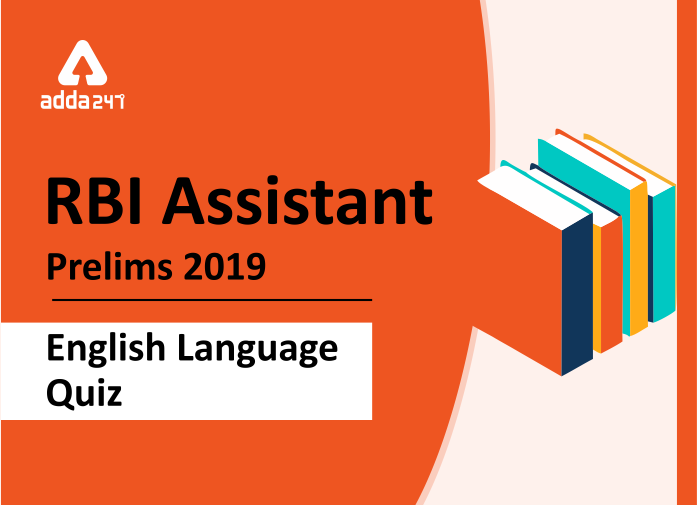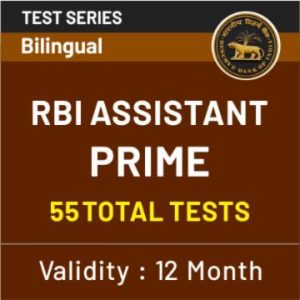English Quiz RBI Assistant Prelims 1st January 2020
English is the most feared subject among students preparing for bank examinations. Though there were many opportunities this year to get your dream job. Doesn’t matter if you didn’t make it. RBI has brought one more golden opportunity and has announced RBI Assistant Prelims 2020. Here, bankersadda is with you at every step of preparation. English will no more be a fearsome subject with English Quiz for RBI Assistant Prelims. The RBI Assistant Prelims is scheduled to be held on14th and 15th February, which means you’ve got enough time to study hard and score well. Keep in touch with bankersadda to get daily English Quiz and boost your preparation for the upcoming bank exam. You can also prepare with the study plan for RBI Assistant available bankersadda website. Visit the site to get helpful RBI Assistant Study Material.
Directions (1-7): Read the following passage and answer the questions. Some words are given in bold to answer some of the questions.
Digital transactions made using RuPay credit cards or UPI QR codes will not attract additional charges for merchants or customers from the beginning of next year, Finance Minister Nirmala Sitharaman said on Saturday. All shops, business establishments and companies with an annual turnover of ₹50 crore or more have been mandated to offer these modes of payment to customers. The Department of Revenue will soon notify RuPay and UPI as the prescribed mode of payment for digital transactions without any Merchant Discount Rate (MDR), Ms. Sitharaman said after a meeting with public sector bankers, adding that the notification would come into effect from January 1, 2020.
The Merchant Discount Rate is the percentage of the digital transaction that a merchant pays to banks. This cost is often passed on to the customer. The decision to choose RuPay and UPI as the platforms which will not attract this levy, may promote these home-grown digital payment pathways over those promoted by foreign companies, including VISA and MasterCard.
In her budget speech in July, the Finance Minister had listed “BHIM UPI, UPI-QR Code, Aadhaar Pay, certain Debit cards, NEFT, RTGS, etc.” as the low-cost digital modes of payment which could be offered without the imposition of MDR in order to promote a “less cash” economy. She had added that “RBI and banks will absorb these costs from the savings that will accrue to them on account of handling less cash as people move to these digital modes of payment.” At that time, the Payments Council of India — an industry lobby group — had said an MDR waiver would hurt companies in the payments system.
It argued that the cost should be borne by the government instead of banks, which would have no incentive to promote digital payments without MDR revenues. On Saturday, Ms. Sitharaman said all banks would start a campaign to promote RuPay debit cards and UPI. The government has already amended two laws — the Income Tax Act and the Payments and Settlement Systems Act — in order to implement the budget announcement, she added.
Q1. Why the government has chosen Rupay and UPI as digital payment platforms?
(a) To avoid the extra MDR cost levied on customers
(b) Promoting domestic digital payment methods
(c) Paving way for the success of foreign companies
(d) Both (a) and (b)
(e) none of these
Q2. How the MDR waiver will be advantageous for RBI and Banks?
(a) Cost of cash handling will be compensated with the cost of MDR
(b) People will pay digitally
(c) The MDR will boost reserves of RBI
(d) It will be beneficial for payment service companies
(e) None of these
Q3. What are the benefits of low cost modes of digital payments enlisted by the Finance Minister?
(a) They don’t require obligation of Merchant Discount Rate.
(b) It can encourage economy with less cash
(c) Both (a) and (b)
(d) Home grown companies will be affected
(e) None of these
Q4. What are the steps taken by the government for the implementation of budget announcement?
(a) Campaigns for promotion of Rupay debit cards
(b) Amendment of Income Tax Act
(c) Amendment of Payments and Settlement Systems Act
(d) All of the above
(e) None of these
Q5. Which of the following is most similar in meaning with ACCRUE highlighted in the passage?
(a) Beheld
(b) Collection
(c) Detain
(d) Ensue
(e) None of these
Q6. Which of the following words is most opposite in meaning with WAIVER highlighted in the passage?
(a) Reserve
(b) Claim
(c) Postpone
(d) Rejection
(e) None of these
Q7. Which of the following pair of words has a synonym and antonym of BORNE highlighted in the passage?
(a) Carry, Bring
(b) Exhibit, Present
(c) Endure, Avoid
(d) Maintained, Holding
(e) None of these
DIRECTIONS (8-15): Eight statements are given in jumbled fashion. Arrange the parts of the statement. Also, one of the parts may or may not contain grammatical error after the arrangement. Based on these five statements, answer the questions following the statements.
(I) throes of what is fast (A)/becoming a gravely culpable (B)/ Uttar Pradesh is in the (C)/crime against humanity(D)
(II) Parliament, certain elements have (A)/ contentious issues out to the streets(B)/ after losing the debate inside (C)/regrettably chose to take some (D)/
(III) do not disrupt the life of the common man(A) /form the core of democratic and (B)/are unexceptionable as long as they (C)/ protests and demonstrations no doubt (D)
(IV) gone are the halcyon days when (A)/life was more orderly and civilised, and (B)/the police just received orders from (C)/above to be executed as faithfully as they could. (D)
(V) devote time to improves the (A)/ senior police officers to (B)/quality of policing in the field (C) /there is a crucial need for (D)/
(VI) leadership in the long run (A) /allowing chiefs of the three (B)/services to make political (C)/statements undermine the civil (D)
(VII) so by heads of institutions(A) /the police cannot enter campuses (B)/unless they are invited to do (C)/ it is fallacy to argue that (D)
(VIII) to treat them if they reported (A)/ that the injuries were inflicted (B)/government hospitals were unwilling (C)/ on them by policepersons(D)
Q8. What will be the correct arrangement of the parts of statement (I)? Also, identify the part which contains grammatical error.
(a) ACBD; B
(b) CABD; no error
(c) BCDA; A
(d) CABD; C
(e) DBAC; D
Q9. What will be the correct arrangement of the parts of statement (III)? Also, identify the part which contains grammatical error.
(a) ACDB; D
(b) CABD; C
(c) DBCA; B
(d) BDCA; A
(e) DBCA; NO ERROR
Q10. What will be the correct arrangement of the parts of statement (V)? Also, identify the part which contains grammatical error.
(a) ACBD; C
(b) CDAB; D
(c) ADBC; A
(d) DBAC; A
(e) None of these
Q11. What will be the correct arrangement of the parts of statement (II)? Also, identify the part which contains grammatical error.
(a) BACD; C
(b) CADB; D
(c) CBDA; A
(d) DABC; C
(e) ACBD; NO ERROR
Q12. What will be the correct arrangement of the parts of statement (IV)? Also, identify the part which contains grammatical error.
(a) DABC; A
(b) ABCD; C
(c) ABCD; B
(d) BACD; C
(e) ABCD; no error
Q13. What will be the correct arrangement of the parts of statement (VIII)? Also, identify the part which contains grammatical error.
(a) ACBD; B
(b) CABD; no error
(c) BCDA; A
(d) CABD; C
(e) DBAC; D
Q14. What will be the correct arrangement of the parts of statement (VI)? Also, identify the part which contains grammatical error.
(a) ACBD; B
(b) CABD; no error
(c) BCDA; D
(d) CABD; C
(e) DBAC; D
Q15. What will be the correct arrangement of the parts of statement (VII)? Also, identify the part which contains grammatical error.
(a) ACDB; D
(b) CABD; C
(c) DBCA; B
(d) BDCA; A
(e) DBCA; NO ERROR
Solutions
S1. Ans. (d)
Sol. Refer to the second paragraph of the passage, the hint can be drawn from the lines, ‘The decision to choose RuPay and UPI as the platforms which will not attract this levy, may promote these home-grown digital payment pathways over those promoted by foreign companies, including VISA and MasterCard.’
Hence, option (d) is the right answer choice.
S2. Ans. (a)
Sol. Refer to the third paragraph, the hint can be drawn from the lines, RBI and banks will absorb these costs from the savings that will accrue to them on account of handling less cash as people move to these digital modes of payment.’
Hence, option (a) is the right answer choice.
S3. Ans. (c)
Sol. Refer to the third paragraph of the passage, the hint can be drawn from the lines, In her budget speech in July, the Finance Minister had listed “BHIM UPI, UPI-QR Code, Aadhaar Pay, certain Debit cards, NEFT, RTGS, etc.” as the low-cost digital modes of payment which could be offered without the imposition of MDR in order to promote a “less cash” economy.’
Hence, option (c) is the right answer choice.
S4. Ans. (d)
Sol. Refer to the last paragraph of the given passage, the hint can be drawn from the lines, On Saturday, Ms. Sitharaman said all banks would start a campaign to promote RuPay debit cards and UPI. The government has already amended two laws — the Income Tax Act and the Payments and Settlement Systems Act — in order to implement the budget announcement, she added.’
Hence, option (d) is the right answer choice.
S5. Ans. (d)
Sol. Accrue means (of a benefit or sum of money) be received by someone in regular or increasing amounts over time, or accumulate or receive (payments or benefits) over time.
Ensue is the word which is most similar in meaning with the given word. Hence, option (d) is the right answer choice.
S6. Ans. (b)
Sol. Claim is most opposite in meaning with the given word. Waiver means ‘an act or instance of waiving a right or claim; Surrender or Renounce.’
Hence, option (b) is the right answer choice.
S7. Ans. (c)
Sol. Endure and Avoid are synonym and antonym respectively of the given word. Hence, option (c) is the right answer choice.
S8. Ans. (b)
Sol. In the given parts of the statements, the correct rearrangement will be CABD. Also, there is no grammatical error in the statement. Hence, option (b) is the most suitable answer choice.
S9. Ans. (c)
Sol. The correct sequence of the given parts of the statement will be DBCA. Also, the error lies in part (B) where “democratic” will be replaced by “democracy”. Hence, option (c) is the most suitable answer choice.
S10. Ans. (d)
Sol. The correct sequence of the given parts of the statement will be DBAC. Also, the error lies in part (A), where “improves” will be replaced with “improve”. Hence, option (d) is the most suitable answer choice.
S11. Ans. (b)
Sol. here, the correct sequence of the parts of sentence will be CADB to make the statement grammatically and contextually meaningful. Also, the error lies in part (D), where “chose” will be replaced with “chosen”, as third form of verb is used with have. Hence, option (b) is the most suitable answer choice.
S12. Ans. (e)
Sol. Among the given parts of the sentence, there is no rearrangement required. Also, there is no grammatical error in the statement. Hence, option (e) is the most suitable answer choice.
S13. Ans. (b)
Sol. Here, the correct sequence of the parts of sentence will be CABD to make the statement grammatically and contextually meaningful. Also, there is no grammatical error in the statement. Hence, option (b) is the right answer choice
S14. Ans. (c)
Sol. Here, the correct sequence of the parts of sentence will be BCDA to make the statement grammatically and contextually meaningful. Also, the error lies in part (D). ‘Undermines’ will be used instead of ‘undermine’. Hence, option (c) is the right answer choice.
S15. Ans. (e)
Sol. Here, the correct sequence of the parts of sentence will be DBCA to make the statement grammatically and contextually meaningful. Also, there is no grammatical error in the statement. Hence, option (e) is the right answer choice.
Watch the video here to know the 40 days preparation strategy for RBI Assistant 2020
You may also like to read:
Register here to get study materials and regular updates!!
All the Best BA’ians for RBI Assistant Prelims 2020!!!





 English Language Quiz For Bank Foundatio...
English Language Quiz For Bank Foundatio...
 English Language Quiz For SBI Clerk Prel...
English Language Quiz For SBI Clerk Prel...
 English Language Quiz For SBI Clerk Prel...
English Language Quiz For SBI Clerk Prel...







